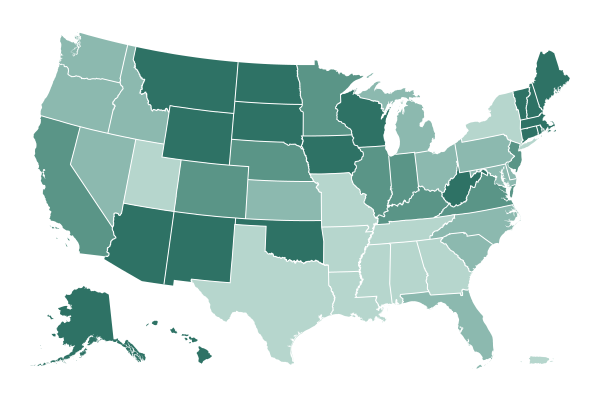For people who have had Covid-19, a single dose of the Pfizer vaccine is enough to provide robust protection from the coronavirus, according to two new studies from Britain that were published late Thursday in The Lancet, a prominent medical journal.
The studies, among the first fully vetted papers to weigh in on how to vaccinate people who have had Covid-19, added strong evidence to the case for giving just one dose of the Pfizer vaccine to people who already have antibodies against the virus.
One of the studies, led by researchers at University College London and Public Health England, described the benefits of that strategy.
“This could potentially accelerate vaccine rollout,” they said. And that in turn could forestall dangerous new mutations: “Wider coverage without compromising vaccine-induced immunity could help reduce variant emergence,” the paper said.
In recent weeks, several studies on the topic were posted online but not yet published in scientific journals, fueling discussions over strategies for vaccinating people who were previously sick. One dose was also enough in those studies to amplify people’s antibodies from an earlier infection.
Some researchers in the United States are trying to persuade the Centers for Disease Control and Prevention to recommend giving only one dose to people who have recovered from Covid-19. The studies from Britain seem likely to put pressure on health officials there to consider the same approach.
More than 28 million people in the United States and four million people in Britain, along with many others whose illnesses were probably never diagnosed, have been infected so far.
One of the new studies — led by Charlotte Manisty, a professor at University College London, and Ashley D. Otter, a research scientist at Public Health England — tracked 51 health workers in London who have submitted to routine tests for antibodies and infection since March. That gave researchers an unusually detailed picture of any pre-existing protection from the virus.
Roughly half of the health workers had been infected, and a single dose of the Pfizer vaccine increased their antibody levels more than 140-fold from their peak levels before being inoculated, the study said. That appeared to give them better protection against the coronavirus than two doses of the vaccine did in people who had never been infected, the researchers wrote.
The study raised the idea of giving people blood tests in the weeks before they became eligible for a Pfizer vaccine to determine whether they already had antibodies. People’s immune responses to an infection are highly variable, making it difficult to predict without a blood test who can be fully protected with a single dose.
As a further benefit of the single-dose strategy, the researchers wrote that it would spare people who have already been infected from the unpleasant side effects that sometimes follow a booster shot in that group.
The second study, led by scientists at Imperial College London, measured the immune responses of 72 health workers who were vaccinated in late December. A third showed signs of having previously been infected.
For those people, one dose of the Pfizer vaccine stimulated “very strong” antibody responses, the study said, as well as “very strong T-cell responses,” referring to another arm of the immune system.
It is not clear how long the post-vaccine immune response will last in people who have previously been infected compared with those who have not.
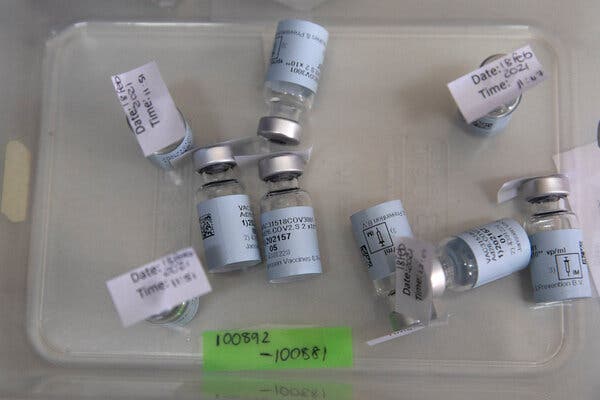
The Food and Drug Administration’s vaccine advisory panel will hold an all-day meeting on Friday to consider whether the coronavirus vaccine made by Johnson & Johnson should be authorized by federal regulators.
The panel is expected to endorse the vaccine, meaning that the United States may have a third one authorized as early as Saturday.
Composed of independent infectious disease experts, statisticians and epidemiologists, the panel will hear presentations from top scientists at Janssen Pharmaceuticals, the drug development arm of Johnson & Johnson. Committee members will then discuss the technical components of the vaccine with them and regulators at the F.D.A.
The committee’s vote is expected to occur late Friday afternoon or early evening.
The meeting participants are equipped with analyses published online this week by the F.D.A. and the company that detail how the vaccine works — its success in preventing moderate and severe cases of Covid-19, hospitalizations and death, as well as the side effects it causes and how its efficacy varied in different regions of the world and among different groups of people.
According to the briefing documents, the vaccine had an overall efficacy rate of 72 percent in the United States and 64 percent in South Africa, where a concerning variant emerged in the fall and has spread to the United States. The vaccine showed 86 percent efficacy against severe forms of Covid-19 in the United States, and 82 percent against severe disease in South Africa.
None of the nearly 22,000 vaccinated people in the trial died of Covid-19.
When the panel met in December to consider the two-dose coronavirus vaccines made by Pfizer-BioNTech and Moderna, the sky-high efficacy rates of those shots led to a consensus and resounding votes to endorse them.
The discussion on Friday could be more complicated.
Johnson & Johnson’s vaccine is a single dose and uses a different kind of technology than the first two authorized vaccines. And the scale and size of the Johnson & Johnson trial was vast, spanning eight countries, three continents and 45,000 participants. That resulted in a large data set that is likely to prompt a more complex — and potentially splintered — discussion.
The F.D.A.’s analysis estimated that the vaccine has an efficacy rate of 74 percent against asymptomatic infections, which suggests that it may help reduce the spread of the virus by vaccinated people. That is likely to be one subject of discussion at the meeting, as the public and health authorities grapple with how vaccination should — or shouldn’t — change behavior when cases remain high.
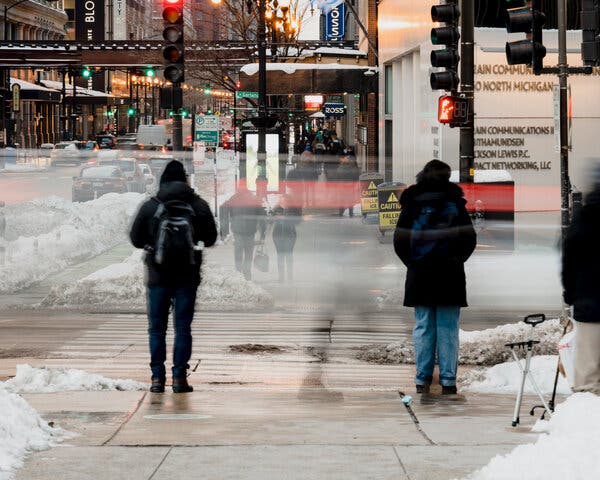
Across the United States and the world, the coronavirus seems to be loosening its stranglehold. The curve of cases, hospitalizations and deaths has yo-yoed before, but never has it plunged so steeply and so quickly.
Is this it, then? Is this the beginning of the end?
The road ahead is potholed with unknowns: how well vaccines prevent further spread of the virus, whether emerging variants remain susceptible enough to the vaccines and how quickly the world is immunized, so as to halt further evolution of the virus.
And the greatest ambiguity is human behavior. Will Americans desperate for a return to pre-pandemic lifestyles continue to wear masks and distance themselves from family and friends? How much longer can communities keep businesses, offices and schools closed?
Covid-19 deaths are unlikely to again rise quite as precipitously as in the past, and the worst may be behind us. But if Americans let down their guard too soon and if the variants spread in the United States as they have elsewhere, another spike in cases may well arrive in the coming weeks.
Buoyed by the shrinking rates over all, governors are lifting restrictions across the United States and are under enormous pressure to reopen completely.
“Everybody is tired, and everybody wants things to open up again,” said Ashleigh Tuite, an infectious disease modeler at the University of Toronto. “Bending to political pressure right now, when things are really headed in the right direction, is going to end up costing us in the long term.”
Looking ahead to late March or April, the majority of scientists interviewed by The Times predicted a fourth wave of infections. But they stressed that it is not an inevitable surge if precautions are maintained for a few more weeks.
“Just hang in there a little bit longer,” Dr. Tuite said. “There’s a lot of optimism and hope, but I think we need to be prepared for the fact that the next several months are likely to continue to be difficult.”
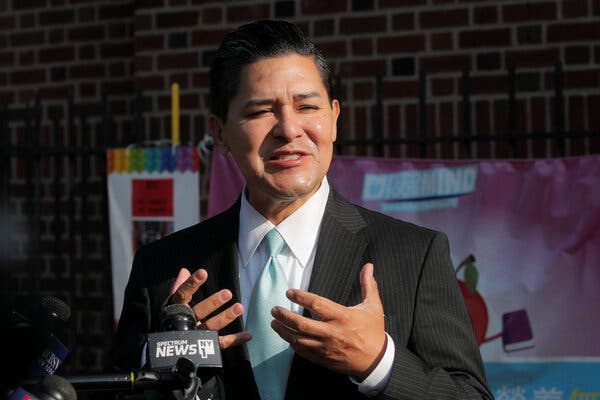
Richard A. Carranza will resign as chancellor of New York City’s public school system, the nation’s largest, in March, city officials announced Friday. The abrupt move comes after disagreements between Mayor Bill de Blasio and Mr. Carranza over school desegregation policy reached a breaking point in recent weeks.
Mr. Carranza, 54, is leaving one of the most influential education jobs in America about three years after he was appointed, and just 10 months before the end of Mr. de Blasio’s second and final term.
He will be replaced by Meisha Porter, a longtime city educator and current Bronx superintendent who will become the first Black woman to lead the sprawling system, which has over 1 million students and 1,800 schools. Ms. Porter, 47, will take over as chancellor on March 15.
“I know the pandemic has not been easy for you, or for any New Yorker,” Mr. Carranza will say to his colleagues at the Board of Education at a news conference on Friday, according to a copy of his prepared remarks. “And I am a New Yorker — a New Yorker who has lost 11 family members and close friends to Covid. A New Yorker who needs to take time to grieve.”
Mr. Carranza’s announcement follows years of tension between the chancellor and the mayor involving who had the final say over major education decisions. The chancellor and other senior education officials sometimes felt that their expertise was overruled or disregarded by Mr. de Blasio, who runs the school district under mayoral control.
The two men repeatedly clashed over school desegregation policy in particular.
Mr. Carranza vowed from his first day as chancellor to tackle entrenched segregation in the city’s schools, while the mayor has largely avoided even using the word. New York is home to one of the most segregated public school districts in the nation, a trend that has worsened over the last few decades as the city has introduced more selective admissions policies for elementary, middle and high school.
It became clear several months into Mr. Carranza’s tenure that the mayor and chancellor had fundamentally different approaches to the problem, particularly when it came to selective admissions policies and gifted and talented programs.
The long-simmering issues came to a head earlier this month, during one heated conversation between Mr. Carranza and Mr. de Blasio over the future of gifted and talented classes, according to several sources with direct knowledge of that conversation. Mr. Carranza drafted a resignation letter after that meeting, but did not immediately quit.
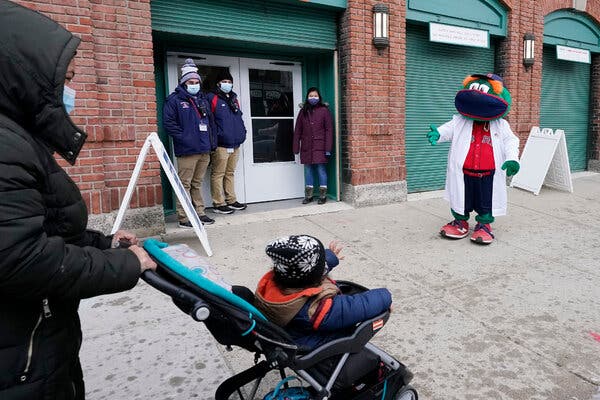
With the coronavirus slowly receding, governors around the United States are beginning to relax pandemic restrictions.
But the rules ae being eased much in the same way as they were imposed: in a patchwork fashion that largely falls along party lines. Republicans are leaning toward rollbacks, and Democrats are staying the course or offering a more cautious approach.
On Thursday, Gov. Greg Abbott of Texas said he was considering lifting a statewide mask mandate that has been in place since July.
“We’re working right now on evaluating when we’re going to be able to remove all statewide orders, and we will be making announcements about that pretty soon,” Mr. Abbott said.
Mr. Abbott, a Republican, has been scrutinized for his handling of the pandemic, especially given the runaway infection rates in the state’s border cities. In November, he ruled out “any more lockdowns,” determined to keep Texas open despite a surge in cases.
As Mr. Abbott weighs easing restrictions, the state’s vaccination effort has yet to fully rebound from the winter storm that knocked out power to millions and crippled water systems across Texas last week.
In Mississippi, Gov. Tate Reeves said he was also considering pulling back some restrictions, particularly mask mandates for people who have been fully vaccinated. Just over 12 percent of the state’s population has received at least one shot, and 5.5 percent have received two.
But in Mississippi and elsewhere, even as a mass vaccination campaign continues to pick up momentum, new dangers loom in the form of more contagious coronavirus variants. The variants might cause new spikes in infections that outpace the gains made by vaccination. So could lapses in social distancing and other precautions.
In Massachusetts, Gov. Charlie Baker, a Republican who has been criticized for a rocky vaccine rollout, said on Thursday that the state would move into the next phase of reopening in March as long as infection rates continue to trend downward. Capacity limits for indoor dining will be lifted starting next week, but bars and nightclubs will remain closed.
Large sports facilities like Fenway Park, Gillette Stadium and TD Garden can reopen at 12 percent capacity starting on March 22, he said.
“We’ve been watching how these venues perform in other states and believe with the right safety measures in place they can operate responsibly and safely here in the commonwealth,” Mr. Baker said.
Red Sox opening day is scheduled for April 1 at Fenway.
In Philadelphia, Health Commissioner Thomas Farley said he, too, was “optimistic” that there would be some fans in the stands for the Phillies’ opening day.
On Wednesday, Gov. Roy Cooper, a Democrat, announced some changes to Covid-19 restrictions in North Carolina, eliminating the state’s nightly curfew and easing occupancy regulations at indoor and outdoor businesses.
The Republican-led North Dakota House of Representatives went a step further, passing a bill on Monday that would prohibit state and local governments from creating future mask mandates. The bill is headed to the State Senate.
Gov. Doug Burgum allowed the state’s mask mandate to expire in January.
Some Democratic leaders are taking more measured steps.
In Virginia, Gov. Ralph Northam said he was easing limits on outdoor gatherings and ending a 12 a.m. to 5 a.m. curfew starting Monday; restaurants and bars will be permitted to serve alcohol until 12 a.m.
“We hope that with trends continuing as they are, that we can look at further steps in the coming months,” Mr. Northam said on Wednesday. “But it’s critical that we do this slowly and thoughtfully.
Gov. Gretchen Whitmer of Michigan said at a news conference on Wednesday that she also planned to ease some restrictions “in the coming days,” though she provided few specifics.
“Our case numbers and public health metrics are trending in the right direction,” she said. “I’m very pleased to see that, and feeling very optimistic.”
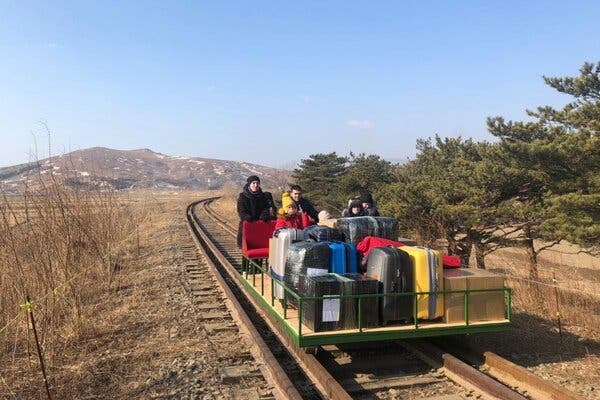
North Korea sealed its borders more than a year ago, grounding flights and shutting its borders with neighboring China and Russia because of the pandemic.
This week, a few Russians found a way out.
Russia’s Foreign Ministry said on Thursday that several employees at its embassy in North Korea had taken an unusual route — one that included a bus ride and a trip on a hand-pushed railcar — to reach the country’s border with Russia.
The group included the embassy’s third secretary, Vladislav Sorokin, and his 3-year-old daughter, the ministry said on its official Facebook page. It also posted a photograph showing several children sitting on the railcar beside suitcases, with adults walking behind them on a railroad track and snow-capped hills in the distance.
When the group arrived at a Russian border post in Siberia, they were met by colleagues from the Foreign Ministry and taken to an airport in Vladivostok, the ministry’s post said.
It was not clear from the post whether the group had broken any North Korean regulations or encountered any police or border officials. The ministry did not immediately respond to an email on Friday requesting further details about the journey.
North Korea closed its borders in January 2020 out of fears that a Covid-19 outbreak could seriously test its underequipped public health system and a domestic economy that was already struggling under international sanctions, analysts say.
The country has also deployed troops along its border with China with “shoot to kill” orders to prevent smugglers from bringing in the coronavirus, Gen. Robert B. Abrams, commander of the United States military in South Korea, said in September.
The North’s leader, Kim Jong-un, said last summer that he would not accept international aid after devastating floods in his country for fear that outside help might bring in the virus, the state news media reported.
But Mr. Kim is apparently willing to import Covid-19 vaccines. According to a report this month by Covax, an international group that has negotiated for vaccine doses, North Korea is expected to receive nearly two million doses of the AstraZeneca shot by the middle of this year.
The North’s state news media has long insisted that the country has no confirmed Covid-19 cases, but outside experts are skeptical.
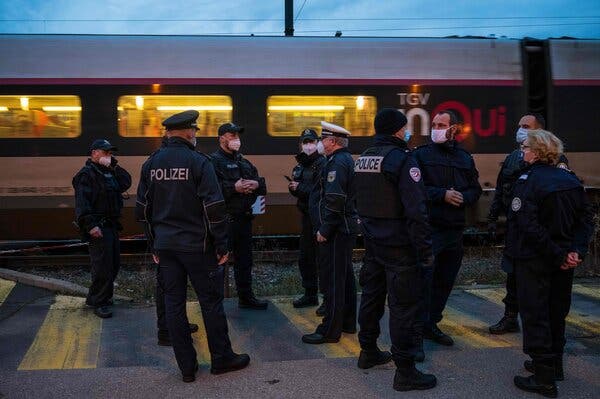
In the latest challenge to Europe’s open borders, the French government announced stricter border checks this week between Germany and the eastern Moselle region of France, one of several areas experiencing a spike in Covid-19 cases and where the authorities are contemplating tightening local restrictions.
It is the most recent effort by a European Union member nation to control the virus’s spread by resurrecting national border checkpoints long absent from the bloc, one of whose fundamental pillars is the free movement of people.
Starting on Monday, nearly all those wanting to cross the border will have to present a negative coronavirus test from the past 72 hours before entering France, Olivier Véran, the health minister, and Clément Beaune, the junior minister in charge of European affairs, said in a statement on Thursday. Only cross-border workers in the area will be exempted.
Last month, France closed its borders to non-European Union countries and made it mandatory for all travelers from within the bloc to present a negative test at the border. Cross-border residents were exempted, regardless of whether they were traveling for work.
The new regulation will apply to all people are crossing the border from Germany into Moselle for nonprofessional reasons like shopping and family visits.
“On both sides of the border, we share the goal of preserving free movement and of enabling cross-border workers to pursue their professional activity,” Mr. Véran and Mr. Beaune wrote in their statement.
The minister also said that cross-border workers would be encouraged to work from home, that the authorities would set up a weekly testing strategy for such workers at the border, and that French and German police patrols would be bolstered in the area to ensure compliance.
Germany has also imposed restrictions on entry from neighboring countries, with much of its focus on preventing people coming from the Czech Republic — where new cases are rising again — from entering without proof that they are not infected with the virus.
Prime Minister Jean Castex of France said at a news conference on Thursday that new virus variants, primarily the one first detected in Britain, now accounted for half of all new infections in the country. He warned that 20 areas around the country — including Paris — could soon see domestic curbs on movement tightened if infections continued to rise and hospitals remained under pressure.
France has resisted imposing a nationwide lockdown, like many of its neighbors, relying instead on a 6 p.m. to 6 a.m. curfew and more targeted measures limiting social interaction.
The stepped-up restrictions could include weekend lockdowns, increased checks at airports and a crackdown on gatherings in public places, similar to measures recently enforced on the French Riviera and in the city of Dunkirk, Mr. Castex said.
Over 85,000 people have died because of the pandemic in France.

While many governments are undertaking ambitious campaigns to persuade people to get vaccinated against Covid, Zimbabwe’s president has gone a step further, threatening to punish those who do not take offered doses.
“You are not going to be forced to be vaccinated, but the time shall come when those who are not vaccinated won’t get jobs,” President Emmerson Mnangagwa said on Wednesday.
Even something as simple as taking a local bus will be forbidden for those who aren’t vaccinated, he said.
The threats come even as the country of 15 million is struggling to secure doses for people who want to be immunized.
Zimbabwe received a donation of 200,000 doses from the Chinese vaccine maker Sinopharm from China, and a further 600,000 doses are expected to arrive in the country early March. Additionally, the country is set to receive more than 1.1 million doses as part of the Covax program, which is distributing vaccines to poor and middle-income countries in an effort to help address global inequities.
Zimbabwe’s frontline health workers are the first in line for vaccination, but as the campaign kicked off in recent days, some resisted the vaccine — voicing particular skepticism about the doses from China.
“I personally won’t accept to be vaccinated,” said Linet Sithole, a nurse in Harare, the Zimbabwean capital. “It is my choice.”
She said she was concerned about the dearth of information about the Chinese vaccine and potential side effects.
Mr. Mnangagwa, addressing supporters in Matabeleland Province, called such concerns unfounded and noted that after the nation’s vice president had the first jab, “he is still here.”
The president, who has yet to be inoculated himself, stopped short of making vaccinations mandatory.
Still, his threats were criticized by some observers as both autocratic and unwise — threatening to further undermine confidence in vaccines that have been proven to be safe and effective at preventing serious illness and death.
Rashweat Mukundu, a researcher at International Media Support, a group focused on debunking false information in the media across African, said Mr. Mnangagwa’s message would bolster fears that the Zimbabwean government has “weaponized Covid-19 and has failed to see this as a public health issue.”
“For me, the message on compulsory vaccination suits the trend we have been seeing, which is Covid-19 as a political tool of control,” he said. “Vaccination is important but must be as a result of public awareness and confidence building, and not threats.”
“We have groups in Zimbabwe who for cultural, religious reasons may not opt for vaccination, and their rights must be respected,” he added.
But Tafadzwa Mugwadi, the director of information for the governing Zimbabwe Africa National Union Patriotic Front, said it was a matter of national security.
“Let that be categorical that those who will deny vaccination will be a risk to others and national security,” he said.
While official statistics on the virus are not regarded as capturing the true scope of the pandemic, Zimbabwe has recorded more than 1,400 deaths since the outbreak of the disease.
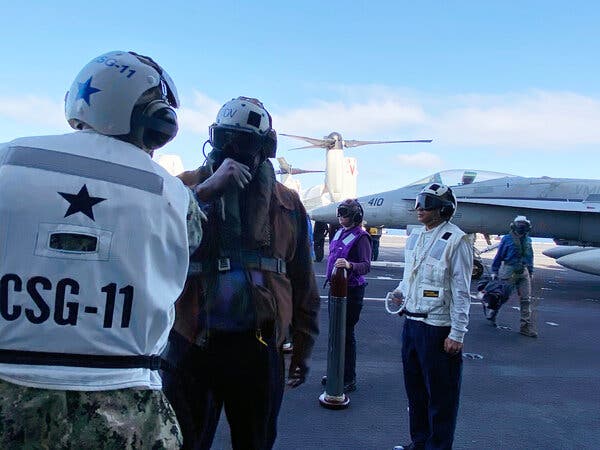
ABOARD U.S.S. NIMITZ, off California — Many Americans might have given almost anything to have escaped the past year in their country, but consider the experience of the crew of the Nimitz.
When the aircraft carrier departed Naval Base Kitsap in Bremerton, Wash., on April 27, George Floyd was still alive. Donald J. Trump was still president. Georgia had two Republican senators. And about 56,000 people in the United States had died of the coronavirus.
Now, 10 months later, the nuclear-powered warship is returning home to a country vastly different from the one it left. That difference was highlighted on Thursday when the new defense secretary — for the first time, an African-American — landed onboard to talk to a travel-weary and isolated crew.
“Secretary of defense in combat!” came the announcement.
Lloyd J. Austin III, his baritone ringing through the ship’s public-address system, told the sailors and pilots on the Nimitz that he knew what it felt like to be cut off from life during extended deployments: Mr. Austin, a retired Army four-star general, was posted in Iraq about a decade ago for a tour even longer than the Nimitz’s.
But that was on land, in Army bases near Baghdad and flying around to Erbil and Ramadi. The Nimitz sailors and Navy and Marine pilots were at sea, spending 2020 in what sometimes felt like a time capsule, sailors said.
They had to quarantine for two weeks before they even boarded the ship and, once on, they basically could associate only with one another, even during port calls.
On the rare occasions that the ship came into port — in Guam or in Manama, Bahrain — the 5,000-strong crew was not allowed traditional shore leave and had to sleep onboard, in berths with around 100 other sailors. They were told not to interact with the public on land because of the pandemic.
They watched the presidential election returns from the Indian Ocean and woke up the morning of Jan. 7, in the Persian Gulf, to the news that rioters had stormed the Capitol.
Among crew members on Thursday, there was a palpable sense of excitement, but also some trepidation about what they would find after 10 months in a bubble at sea.
Some had lost family members to Covid-19 — after all, more than 450,000 more people in America had died of the disease while the Nimitz was sailing the world.
Petty Officer First Class Christina Ray, 31, said she was hopeful but wary.
“I am filled with so many emotions,” she said. “We’ve been so removed from the world, and now it’s like, ‘How do I be normal?’”
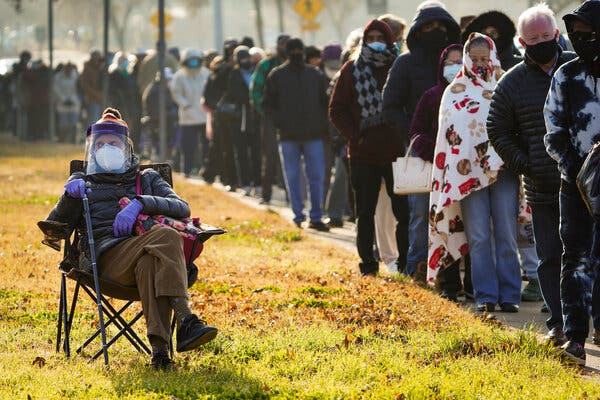
Reports of new vaccinations have started to increase again across the United States after a week of declines brought on by severe weather.
The country administered an average of about 1.5 million reported doses a day in the seven-day period ending Thursday, according to federal data, a slight increase from a low point of 1.4 million doses a day through Tuesday.
The Centers for Disease Control and Prevention reported on Thursday that nearly 68.3 million doses of vaccine had been administered across the country since the U.S. vaccination campaign began in December. Since Jan. 20, the C.D.C. has reported the administering of more than 50 million shots across the country.
But even as the pace of vaccination rebounds, it remains well below the roughly 1.7 million doses the country was averaging each day before a powerful winter storm disrupted shipping nationwide last week and forced vaccination sites to close in parts of the South and Midwest.
The average number of daily doses administered across the country had been steadily increasing as the two federally authorized vaccine manufacturers, Pfizer and Moderna, became more efficient and expanded production for their two-dose vaccines.
While that acceleration had been expected well before President Biden assumed office, officials have been anxious to highlight every increase in shipments as evidence that the new administration is strongly tackling the pandemic. A third vaccine, from Johnson & Johnson, which is a one-dose vaccine, is expected to be authorized soon.
On Thursday, Mr. Biden watched two firefighters and a Safeway grocery store manager get vaccinated at an event in Washington and used the moment to mark the nation’s progress toward goal — considered fairly unambitious by many many experts — he set before he took office: 100 million shots in his first 100 days.
“We’ve been laser-focused on the greatest operational challenge this country’s ever undertaken,’’ he said. “We are going from a mess we inherited to moving in the right direction.”
At one point, Mr. Biden suggested without specifics that in late April or May there may be more vaccines available than people willing to take them.
“We’re gong to hit a phase in this effort, maybe as late as April or May, when many predict, instead of long lines of people waiting to get a shot, we’ll face a very different scenario: We’ll have the vaccine waiting,” he said.
The president’s optimism about supply tracks with congressional testimony from vaccine manufacturer officials earlier in the week. Pfizer and Moderna executives said they would deliver a total of 400 million doses by the end of May, and 600 million by the end of July. Johnson & Johnson has pledged 20 million doses by the end of March and 100 million doses by the end of June if its shot is authorized.
But on Thursday, Mr. Biden repeated his warning that “this is not a victory lap” and said he could not predict regular public life might resume.
Sharon LaFraniere contributed reporting.
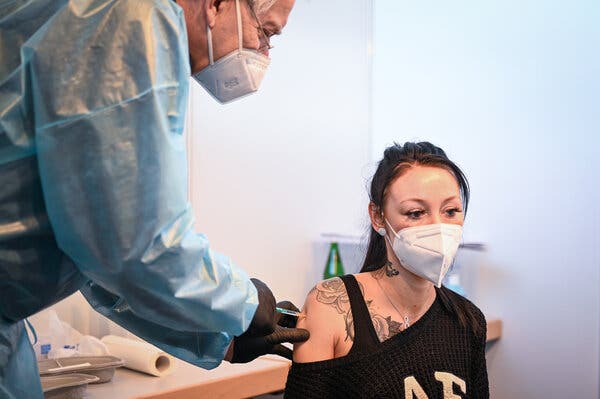
BERLIN — A preference for the vaccine developed by the German company BioNTech with Pfizer is causing a surplus in Germany of the shot developed by AstraZeneca, a British-Swedish company, according to state health officials.
Many people — including health workers — are skipping appointments or declining to sign up for the AstraZeneca shot, which they fear is less effective than the Pfizer-BioNTech vaccine, the officials say. As a result, two weeks after the first delivery of 1.45 million doses of the AstraZeneca vaccine arrived in Germany, only 270,986 have been administered, according to data collected by the public health authority.
“Vaccinating fast is the order of the day,” Germany’s president, Frank-Walter Steinmeier, said Thursday during a videoconference in Bavaria, stressing that all three vaccines in use in Germany had been approved by the European Medicines Agency and were trustworthy.
“I personally have little sympathy for the reluctance to use one vaccine or another,” he said. “This is a first-world problem, certainly for those who are still waiting for their first vaccination and even more so for people in countries who might not even have the prospect of receiving a first inoculation this year.”
The rejection of the AstraZeneca vaccine has been fueled by weeks of negative coverage about it in the German news media, which has portrayed it as “second-class,” citing its lower efficacy rate compared with the Pfizer-BioNTech vaccine and reporting stories of people suffering adverse reactions.
Clinical trials do suggest that Pfizer’s efficacy, at 95 percent, is higher than AstraZeneca’s, which is 60 to 90 percent depending on factors such as the spacing of doses. Still, it is difficult to directly compare shots unless they are tested head-to-head in the same trial. And many health professionals suggest getting whichever vaccine is available first, since Covid-19 poses such significant health risks.
Widespread skepticism in Germany about vaccines has exacerbated people’s reluctance to take the AstraZeneca shot. Medical and other frontline workers have also expressed resentment about being given unused AstraZeneca shots instead of the Pfizer-BioNTech one, saying that such a policy showed a lack of respect after their efforts to help the country respond to the pandemic over the past year.
The rejection of the AstraZeneca vaccine has caused delays in a mass vaccination campaign that was already struggling with bureaucratic and logistical hurdles. That has raised concerns that failure to immunize people quickly enough could stymie efforts to return the country to public life. New coronavirus infections are increasing even as Germany remains largely locked down.



